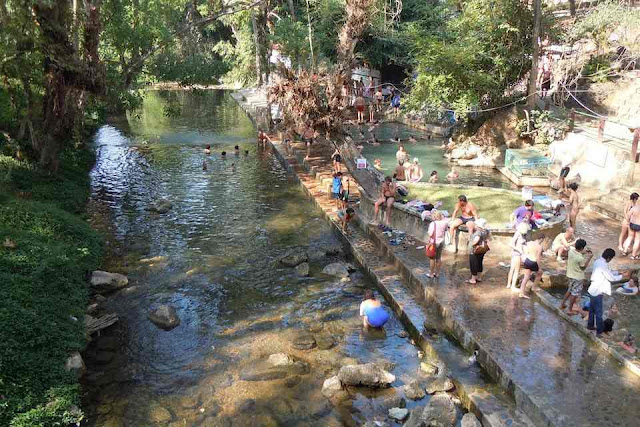Visit the park with Safarine Tours...
Sai Yok National Park, อุทยานแห่งชาติไทรโยค, offers both natural and historical sites. It is one of the seven national parks of KanchanaburiThe park is near the border of Burma, a hundred kilometers from Kanchanaburi. Its surface is three hundred square kilometers. Inside is a part of the old railway line, built by the Japanese, which connected Thailand to Burma during the Second World War.
 |
| Floating hotel under the waterfall of Sai Yok Yai |
 |
| Sai Yok Yai Waterfall (Khao Jon) - Dry Season |
The waterfall of Sai Yok Yai and Sai Yok Lek are the most beautiful. Calcareous caves dot the park: Tham Sai Yok, Tham Phra and Tham Kaew are home to small bats, the pork-nosed kitti
The species was discovered by Kitti Thonglongya whose name it bears: Cristallisantes thonglongyai. Kitti is the only species of the genus Craseonycteris, itself the only genus of the family Craseonycteridae. The kitti with pork nose, is a species in danger. She lives in western Thailand and south-east Burma, where she occupies limestone caves along the rivers.
She has a gray or reddish coat or, with a muzzle similar to the snout of a pig. The colonies comprise on average about a hundred individuals in a cave. She feeds briefly at dawn and in the evening. These periods of activity are quite short. Kitti fly around forest surroundings to hunt insects. Females give birth to only one young each year.
 |
| Kitti with pork nose - 2 grams |
In Thailand, Kitti is confined to a small part of Kanchanaburi Province in the Kwai Noi River Basin. Kitti feed on hymenopteran and small flies. In April, at the end of the dry season, females give birth to a single baby. During the breastfeeding period, the young person stays on the perch or remains stuck to the mother at one of the two pubic nipples. Kitti is one of the two smallest mammals in the world.
Le pu chao fa and Photo Club de Ranong
There are also gibbons, Chinese porcupine (Hystrix brachyura), commonly known as Porcupine from Malaysia. This porcupine is 72 centimeters long and weighs about 2,400 grams. It is distinguished from other Hystrix species by the absence of crest on the head and back. Its color is mostly brown, with a white mark on the throat. Its caudal spines are ringed with black and yellow, lemurs and wild elephants.
 |
| Boat towing a floating pontoon on the Kwai Noi River |
A boat allows to visit Tham Dao Wa Dung, one of the most beautiful caves of all Thailand. Nearby the hot springs of Hin Dat are very popular with tourists.
In Sai Yok National Park
 |
| Lawa caves |
Tham Kaeo (Cave of Glass) is a rather small cave with stalactites and stalagmites. A very narrow entrance gives access after twelve meters to the first bedroom. In the spring a pond is formed in one of the rooms;
Daung Cave Daung is a hundred meters long with eight halls adorned with stalactites and stalagmites, the Comb Hall, the Raya Hall, the Chedi Hall, the Jeeb Manfa Hall ...;
Lawa Cave, twenty kilometers to the east is renowned for its splendid stalagmites and stalactites;
- The Sai Yok Lek Waterfall is located five hundred meters south of the Sai Yok Yai waterfall and rushes into Kwai Noi River. Its water, which comes from the mountains of Erawan, is very fresh;
- Sai Yok Yai Waterfall. The Nong Kop stream joins the Sai Yok River (another name for Kwai Noi) at this waterfall also known as Khao Jon. ;
- The Sai Yok Noi Waterfall is often associated with Sai Yok Park although it belongs to Erawan Park. The Khao Phang River, which originates in the Erawan Plateau, feeds this beautiful Khao Phang Waterfall, better known as the Sai Yok Noi Waterfall in Nam Tok. This cascade of water and limestone is very pleasant to visit between July and September, when the water is abundant.
- Nature Trails are historic trails with beautiful flowers.
 |
| Hot spring water Hindat |
In the immediate vicinity of the famous and very tourist hot springs of Hindat.
Kanchanaburi
Want to discover a preserved nature? The
verdant Kanchanaburi region of western Thailand offers a privileged and
easily accessible environment. Safarine will share with you his passion
for its wild nature and its inhabitants.
Comments
Post a Comment